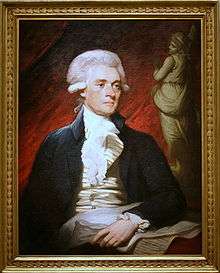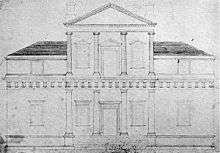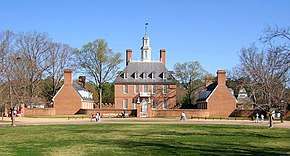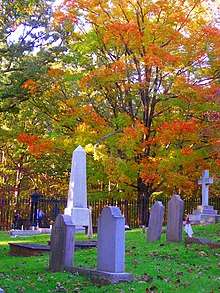Martha Jefferson
Martha Skelton Jefferson (née Wayles; October 19 or 30, 1748 – September 6, 1782) was the wife of Thomas Jefferson. She served as First Lady of Virginia during Thomas' term as Governor from 1779 to 1781, but did not serve as First Lady of the country because she died in 1782, 19 years before he became President.[1][2]
Martha Jefferson | |
|---|---|
 | |
| First Lady of Virginia | |
| In office June 1, 1779 – June 3, 1781 | |
| Preceded by | Dorothea Henry |
| Succeeded by | Anne Fleming |
| Personal details | |
| Born | Martha Wayles October 19, 1748 Charles City, Virginia, British America |
| Died | September 6, 1782 (aged 33) Charlottesville, Virginia, U.S. |
| Spouse(s) | |
| Children | |
| Mother | Martha Eppes |
| Father | John Wayles |
Of the six children born to Thomas and Martha, only two survived to adulthood, Martha and Mary. Martha died four months after the birth of her last child.[1] It is widely held that Thomas had a long-standing relationship and children with Martha's half-sister, Sally Hemings, a favored slave who was three-quarters white.[3] Thomas burned their letters to each other and rarely spoke of her, so she remains a somewhat enigmatic figure.[4] (Similarly, Jefferson did not speak much of his mother, Jane Randolph Jefferson, or his best friend.)[5][lower-alpha 1]
Early life and education
Martha Wayles was born on October 19 or 30, 1748,[6] the daughter of Martha Eppes Wayles (1721–1748) and John Wayles (1715–1773) of The Forest plantation[1] near Colonial Williamsburg[2] in Charles City County, Virginia.[7] Their only child,[8] Martha was nicknamed "Patty".[9] John Wayles was an attorney, slave trader, business agent for Bristol-based merchants Farrell & Jones, and prosperous planter.[10][11] Born in Lancaster, England, he emigrated to the Colony of Virginia, probably in the 1730s.[8] Martha Eppes Wayles was a daughter of Francis Eppes of Bermuda Hundred,[8][12] an early Virginia settlement along the Appomattox River.[13] While little is known of Martha Eppes Wayles' life, she had an appreciation for fine literature, such as her favorite novel, Tristram Shandy[4] and Les Aventures de Télémaque. (Her rebound version of the book, The Adventures of Telemachus, contains her signature on the title page and resides at the Library of Congress).[14]
Martha Wayles had two stepmothers, neither of whom lived long after their marriages to John Wayles, and through one stepmother she had four half-sisters.[8][15][lower-alpha 3] of Malvern Hill. They had four children: Sarah, Elizabeth, Tabitha and Anne.[8] Sarah died in infancy.[8] Tabitha and Anne married the Skipwith brothers, Robert and Henry, respectively. Tabitha Skipwith died with her first childbirth. Nancy Skipwith, "Aunty Skipwith" to the Jefferson children and grandchildren, died in 1798. Elizabeth married Francis Eppes, Martha's cousin, and had two sons, Richard and John Wayles Eppes, the latter of whom married Thomas Jefferson's second daughter, Mary Jefferson.[12] Wayles' second wife died after the birth of Anne in August 1756 and before he married his third wife in January 1760.[8]
On January 26, 1760, Wayles married his third wife, Elizabeth Lomax Skelton (she was the widow of Reuben Skelton, an older brother of Bathurst Skelton, his daughter Martha's first husband). Without producing a child with Wayles, she died on February 10, 1761.[8]</ref> after which John Wayles took Betty Hemings as a mistress, and gave Martha additional half-siblings.[17][lower-alpha 4] or concubine.[8][18][lower-alpha 5] Born into slavery, the children of this union were three-quarters European in ancestry and half-siblings to Martha and Elizabeth Wayles.[3] The youngest was Sally Hemings, born in July 1773, two months after her father's death.[20][21]</ref> Martha likely received her education—including literature, dance, music, French language and Bible study— from private tutors or women in the family. She became the "Lady of the House" after her second stepmother died when she was 13 years of age and was often a hostess to John Wayles' social events and helped manage his business and household affairs.[15] She knew how to make candles, soap, butter and remedies for illnesses.[22]
Marriages and children
Martha Wayles first married Bathurst Skelton (born 1744), an attorney, on November 20, 1766. Their son, John, was born on November 7, 1767. Bathurst Skelton died on September 30, 1768. Martha moved back to The Forest following her husband's death. Three-year-old John died on June 10, 1771.[1][22]

Her third cousin,[23] Thomas Jefferson likely began courting Martha in December 1770.[1] They shared an interest in horse-back riding, literature, and music.[22] As part of Martha's dowry for their January 1, 1772 wedding,[2] Thomas and Martha received property, including the Elk Hill plantation, where Martha had lived with her first husband,[24] and a great number of slaves, which helped Thomas complete the construction of the Monticello residence and landscaping of the estate's 5,000 acres.[22][24][lower-alpha 6] While Monticello was undergoing construction and Thomas was away, Martha often stayed at the Elk Hill plantation.[26]
They had six children, but only two daughters reached adulthood.[1] An unnamed son, Jane Randolph, and Lucy Elizabeth, who died of whooping cough, died as infants.[1] Only the eldest, Martha "Patsy" Jefferson, survived past the age of 25:[22]
- Martha "Patsy" Jefferson[2] (September 27, 1772 – October 10, 1836)
- Jane Randolph Jefferson (April 3, 1774 – September 1775)
- unnamed son[27] (May 28 – June 14, 1777), lived for 17 days
- Mary "Maria or Polly" Jefferson[2] (August 1, 1778 – April 17, 1804)
- Lucy Elizabeth Jefferson (November 3, 1780 – April 15, 1781/April 15, 1782)
- Lucy Elizabeth Jefferson (May 8, 1782 – October 13, 1784/November 17, 1785)
Slaves and Wayles' estate
Martha and Thomas Jefferson acquired a number of slaves as part of her dowry for her marriage, and later from the estate of John Wayles, which made Thomas the second largest slave owner in Albemarle County. The dowry increased the number of slaves he owned from 52 to 187.[24]
Among the more than 100 slaves were Betty Hemings, of mixed-race ancestry, and her 10 mixed-race children. The youngest, an infant, was Sally Hemings. The six youngest were three-quarters white in ancestry and half-siblings of Martha Wayles Jefferson, as they were fathered by her father. Betty also had four children born before those of Wayles'. All the Hemings family members gained privileged positions among the slaves at Monticello, where they were trained and worked as domestic servants, chefs, and highly skilled artisans.[28] Sally Hemings, who was fathered by John Wayles, was the half-sister of Martha Wayles Jefferson, and the subject of a scandal about her relationship with Thomas Jefferson.[24]
Martha's father, John Wayles, died at age 58 in 1773. He left substantial property, including slaves, but the estate was encumbered with debt.[29] Upon Wayles' death, Betty Hemings and her six children with John Wayles were moved "without hesitancy" to Monticello to prevent the Hemings from being separated.[30] The estate was worth ₤30,000, but was in debt to Farrell and Jones in Briston for ₤11,000. Wayles three sons-in-law, including Thomas Jefferson, decided to break up the estate and its debts.[31] Martha and her husband Thomas Jefferson inherited the Willis Creek and Elk Hill plantations and a total of 135 people, including members of the Hemings family.[32] They also inherited ₤4,000 in debt.[33] Jefferson and other co-executors of the Wayles estate worked for years to clear the debt[34] and the overwhelming debt led to Thomas Jefferson's financial ruin.[24]
Temperament and appearance

There are no surviving contemporaneous portraits of Martha Jefferson, but she has been described by family members and Isaac Granger Jefferson as small, graceful, and pretty and like her daughter, Mary Jefferson Eppes. She was described by Robert Skipwith, her sister's husband, as having possessed "... the greatest fund of good nature ... that sprightliness and sensibility which promises to ensure you the greatest happiness mortals are capable of enjoying."[1] As Thomas was having Monticello built, he obtained a piano forte from England for Martha as a wedding present.[24] She played the harpsichord piano forte, while Thomas Jefferson played violins. It was said that Martha played the Harpsichord "very skilfully and who, is in all respects a very agreeable sensible and accomplished lady," according to a Hessian officer, Jacob Rubsamen, who visited Monticello in 1780.[1]

According to her daughter, Martha Jefferson was highly educated and musical, a constant reader, with a good nature and a vivacious temper that sometimes bordered on tartness. She had great affection for her husband. She was a little over five feet tall, with a lithe figure, auburn hair, and hazel eyes.[15][2] She was an accomplished needlewoman, some of her embroidery still exists.[20][15] Martha maintained a collection of notes regarding her household duties and recipes, such as butchering and curing meat and the creation of large batches of soft and hard soap, candles, and beer. During her first year of marriage she began the practice of brewing beer, producing 170 gallons that year.[35]
First lady of Virginia

Martha Jefferson was First Lady of Virginia from 1779 to 1781, during the American Revolution.[36] In that capacity, and in response to a request from Martha Washington, Mrs. Jefferson led a drive among the women of Virginia to raise funds and supplies for her state's militia in the Continental Army to the extent that her health permitted.[37] The letter to James Madison's mother, Eleanor Conway Madison, is the only letter written by Martha Jefferson known to now exist.[38] She published an appeal in the Virginia Gazette, announcing that collections would be taken in the churches. Nationally, the Ladies Association raised $300,000 to buy linen shirts for Washington's army.[37][39] Mrs. Jefferson also contacted other prominent Virginians to raise funds for the troops, including Nelly Madison, mother of James Madison.[37]
Health problems and death

Managing the Jefferson household became increasingly difficult for Martha Jefferson, who had endured at least one case of smallpox, may have had diabetes, and was weakened by her numerous pregnancies,[36] which would ultimately kill her.[9] She bore the stress of having to flee a British invasion of Richmond in early January 1781 and a raid on Monticello in June of that year,[2] during which she had to travel with infant children, many of whom died. She was aware that the British were interested in capturing her or her husband.[36]
Thomas limited his political service due to her health.[2] Jefferson, in Philadelphia for the Second Continental Congress of 1776 that drafted the Declaration of Independence, wished to return to her as soon as possible.[36] Thomas served as governor and in the House of Delegates in Virginia. He rejected the offer to serve as the as a commissioner to France made by the Continental Congress while she was alive.[2][lower-alpha 7]
The birth of their youngest child in May 1782 was reportedly the most difficult pregnancy for Mrs. Jefferson, having carried a very large baby.[36][lower-alpha 8] Edmond Randolph wrote in the month of her death that Thomas was "inconsolable" about Martha's declining health and pain."[1] Mrs. Jefferson's health worsened and she died on September 6, 1782, four months after the birth of her last child. Jefferson was inconsolable.[20][lower-alpha 9] She was buried at Monticello and her tombstone included the words from Thomas' perspective: "Torn from him by death" and "This monument of his love is inscribed".[1]
So that her children would not grow up with stepmothers,[36] Martha had asked Thomas Jefferson to never marry again, and he never did. Her request has been attributed to her own disagreeable relationships with her step-mothers. At her death, she was 33; he was 39.[40]
Notes
- See Jane Randolph Jefferson § Relationship with Thomas
- His wife's name is also given as Mary Cocke.<ref>Schwartz, Marie Jenkins (April 6, 2017). Ties That Bound: Founding First Ladies and Slaves. University of Chicago Press. p. 131. ISBN 978-0-226-46072-7.
- Wayles married Tabitha Cocke,[8][16][lower-alpha 2]
- After the death of his third wife, Wayles took the then 26 year-old Betty Hemings as his mistress<ref name='Monticello - Wayles/Hemings'>"John Wayles", Thomas Jefferson Encyclopedia, Monticello, accessed 10 March 2011. Sources cited on page: Madison Hemings, "Life Among the Lowly," Pike County Republican, March 13, 1873. Letter of December 20, 1802 from Thomas Gibbons, a Federalist planter of Georgia, to Jonathan Dayton, states that Sally Hemings "is half sister to his [Jefferson's] first wife."
- Although there were sources that believed that Wayles fathered children with Betty Hemings, author William G. Hyland, Jr. did not believe that Wayles had Betty as a mistress.[19]
- After the wedding, the couple left The Forest plantation for Monticello. A heavy snowfall began on the afternoon of their journey and produced two feet of snow. As a result, they had to forgo their carriage. Their horses were swapped for two fresh horses at Blenheim Estate of Jefferson's friend, Edward Carter. Martha and Thomas completed the remaining seven-mile leg of their journey of narrow paths.[25] Thomas Jefferson described his outlook for the marriage: "In every schemings of happiness she is placed in the fore-ground of the picture, as the principal figure. Take that away, and it is not a picture for me."[25]
- He served as commissioner to France beginning in 1784. He took his eldest child, Patsy, with him and later sent for his second daughter, Polly.[2]
- Martha wrote the following from Tristam Shandy just before she died.[1][38]
On the same document, Thomas responded to these lines with "and every time I kiss thy hand to bid adieu, every absence which follows it, are preludes to that eternal separation which we are shortly to make!" It is the rare document that Thomas Jefferson did not destroy of his wife's handwriting.[1][38] Thomas had written to Marquis de Chastellux of his state of suspense over the summer following the birth of Lucy Elizabeth.[1]Tristam Shandy
Time wastes too fast: every letter
I trace tells me with what rapidity
life follows my pen. The days and hours
of it are flying over our heads like
clouds of windy day never to return–
more. Every thing presses on– — Laurence Sterne - At his wife's death, Thomas "was led from the room almost in a state of insensibility by his sister Mrs. Carr, who, with great difficulty, got him into his library where he fainted, and remained so long insensible that they feared he would never revive."[20] After the funeral, he withdrew to his room for three weeks. Afterward, he spent hours riding horseback alone around Monticello. His daughter Martha Jefferson Randolph wrote, "In those melancholy rambles I was his constant companion, a solitary witness to many a violent burst of grief."[20] Not until mid-October did Jefferson begin to resume a normal life when he wrote, "emerging from that stupor of mind which had rendered me as dead to the world as was she whose loss occasioned it."[20]
References
- Wilson, Gaye (October 10, 1998). "Martha Wayles Skelton Jefferson". www.monticello.org. Retrieved January 2, 2020.
- George Bush White House (Archives). "Biography of Martha Jefferson". georgewbush-whitehouse.archives.gov. Retrieved January 2, 2020.
- "John Wayles". Monticello. Archived from the original on July 22, 2012. Retrieved January 25, 2012.
- Schwartz, Marie Jenkins (April 6, 2017). Ties That Bound: Founding First Ladies and Slaves. University of Chicago Press. p. 129. ISBN 978-0-226-14755-0.
- William G. Hyland Jr. (February 26, 2015). Martha Jefferson: An Intimate Life with Thomas Jefferson. Rowman & Littlefield Publishers. pp. 134–135. ISBN 978-1-4422-3984-5.
- James, Edward T.; James, Janet Wilson; Boyer, Paul S.; College, Radcliffe (1971). Notable American Women, 1607-1950: A Biographical Dictionary. Harvard University Press. pp. 271. ISBN 978-0-674-62734-5.
- "The Forest". www.monticello.org. Retrieved January 2, 2020.
- Berkes, Anna (November 12, 2007). "John Wayles". www.monticello.org. Retrieved December 31, 2019.
- Hyland, William G. (February 26, 2015). Martha Jefferson: An Intimate Life with Thomas Jefferson. Rowman & Littlefield. p. 115. ISBN 978-1-4422-3984-5.
- Kierner, Cynthia A. (2012). Martha Jefferson Randolph: Her Life and Times. Univ of North Carolina Press. p. 17. ISBN 978-0-8078-3552-4.
- Hyland, William G. (February 26, 2015). Martha Jefferson: An Intimate Life with Thomas Jefferson. Rowman & Littlefield. p. 39. ISBN 978-1-4422-3984-5.
- Malone, Dumas (January 30, 1948). Jefferson the Virginian -. St. Martin's Press. p. 432. ISBN 978-0-316-54474-0.
- McCartney, Martha W. (2007). Virginia Immigrants and Adventurers, 1607-1635: A Biographical Dictionary. Genealogical Publishing Com. pp. 55–56. ISBN 978-0-8063-1774-8.
- "Sowerby Catalogue Volume IV : page 434". tjlibraries.monticello.org. Retrieved January 2, 2020.
- Hendricks, Nancy (October 13, 2015). America's First Ladies: A Historical Encyclopedia and Primary Document Collection of the Remarkable Women of the White House: A Historical Encyclopedia and Primary Document Collection of the Remarkable Women of the White House. ABC-CLIO. pp. 19–20. ISBN 978-1-61069-883-2.
- Hyland, William G. (February 26, 2015). Martha Jefferson: An Intimate Life with Thomas Jefferson. Rowman & Littlefield. p. 237. ISBN 978-1-4422-3984-5.
- Blassingame, John (1977). Slave Testimony: Two Centuries of Letters, Speeches, Interviews, and Autobiographies. p. 475. ISBN 0807102733.
- Hyland, William G. (February 26, 2015). Martha Jefferson: An Intimate Life with Thomas Jefferson. Rowman & Littlefield. p. 219. ISBN 978-1-4422-3984-5.
- Robert P. Watson and Richard Yon, "The Unknown Presidential Wife: Martha Wayles Skelton Jefferson" Archived October 15, 2013, at the Wayback Machine, Jefferson Legacy Foundation, 2003, Quote: "(Wayles never remarried but had five children – Nance, Critta, Thenia, Peter, and Sally – to his slave Elizabeth "Betty" Hemings, the youngest of which would become famous for her relationship with Thomas Jefferson.)" Note: This varies from the Monticello website on the number and some of the names. Accessed 7 January 2012
- "Elizabeth Hemings", Plantation and Slavery, Monticello, accessed 7 January 2012. Note: The Monticello website says that Hemings' children by Wayles were Robert, James, Thenia, Critta, Peter, and Sally.
- Hendricks, Nancy (October 13, 2015). America's First Ladies: A Historical Encyclopedia and Primary Document Collection of the Remarkable Women of the White House: A Historical Encyclopedia and Primary Document Collection of the Remarkable Women of the White House. ABC-CLIO. p. 20. ISBN 978-1-61069-883-2.
- Roberts, Gary Boyd (April–May 1993). "The Royal Descents of Jane Pierce, Alice and Edith Roosevelt, Helen Taft, Eleanor Roosevelt, and Barbara Bush". American Ancestors. Boston: New England Historic Genealogical Society. Archived from the original on December 3, 2010. Retrieved October 18, 2014.
...Mrs. Martha Wayles Skelton Jefferson (1748-82), wife of Bathurst Skelton and Thomas Jefferson, was a third cousin of her second husband...
- Kranish, Michael (January 21, 2010). Flight from Monticello: Thomas Jefferson at War. Oxford University Press. pp. 38. ISBN 978-0-19-974590-6.
- Kranish, Michael (January 21, 2010). Flight from Monticello: Thomas Jefferson at War. Oxford University Press. pp. 39. ISBN 978-0-19-974590-6.
- Hyland, William G. (February 26, 2015). Martha Jefferson: An Intimate Life with Thomas Jefferson (in Arabic). Rowman & Littlefield. p. 94. ISBN 978-1-4422-3984-5.
- Quinn, Sandra L.; Kanter, Sanford (1995). America's Royalty: All the Presidents' Children. Greenwood Publishing. p. 19.
- "Monticello Explorer: Elizabeth Hemings (1735-1807)". explorer.monticello.org. Retrieved October 20, 2017.
- Death notice from The Virginia Gazette, June 3, 1773: "On Friday last died, at his house in Charles City, JOHN WAYLES, Esquire, attorney at law."
- Meacham, Jon (2012). Thomas Jefferson. Random House. pp. 60.
- Meacham, Jon (2012). Thomas Jefferson: The Art of Power. p. 70. ISBN 9781400067664.
- Schwartz, Marie Jenkins (April 6, 2017). Ties That Bound: Founding First Ladies and Slaves. University of Chicago Press. pp. 142–143. ISBN 978-0-226-46072-7.
- Onuf, Peter S.; Onuf, Peter S. (1993). Jeffersonian Legacies. University of Virginia Press. p. 148. ISBN 978-0-8139-1463-3.
- Sloan, Herbert E. (2001). Principle and Interest: Thomas Jefferson and the Problem of Debt. University of Virginia Press. pp. 15–26. ISBN 978-0-8139-2093-1.
- Kukla, Jon (June 3, 2009). Mr. Jefferson's Women. Knopf Doubleday Publishing Group. pp. PT112. ISBN 978-0-307-53867-3.
- Hendricks, Nancy (October 13, 2015). America's First Ladies: A Historical Encyclopedia and Primary Document Collection of the Remarkable Women of the White House: A Historical Encyclopedia and Primary Document Collection of the Remarkable Women of the White House. ABC-CLIO. pp. 20–21. ISBN 978-1-61069-883-2.
- Kukla, John. Mr. Jefferson's Women, p. 118 (New York: Knopf Books, 2007).
- Hendricks, Nancy (October 13, 2015). America's First Ladies: A Historical Encyclopedia and Primary Document Collection of the Remarkable Women of the White House: A Historical Encyclopedia and Primary Document Collection of the Remarkable Women of the White House. ABC-CLIO. pp. 23–24. ISBN 978-1-61069-883-2.
- Hendricks, Nancy. America's First Ladies: A Historical Encyclopedia and Primary Document Collection of the Remarkable Women of the White House, p. 23 (ABC-CLIO, 2015).
- Hyland Jr., William G. Martha Jefferson: An Intimate Life with Thomas Jefferson. Lanham, MD: Rowman and Littlefield, 2015; pg. 1
External links
- Colonial Williamsburg: Interview of Martha Jefferson, YouTube
- Martha Wayles Skelton Jefferson, Monticello: For accurate, up-to-date information written and moderated by historians at Thomas Jefferson's Monticello.
- Martha Jefferson at Find a Grave
- "Martha Jefferson", First Lady Biography